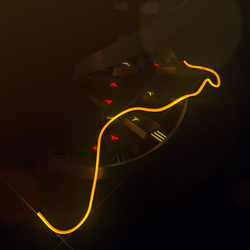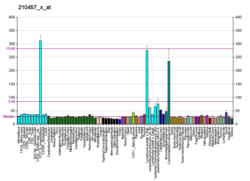HMGA1
High-mobility group protein HMG-I/HMG-Y is a protein that in humans is encoded by the HMGA1 gene.[5][6]
Function[]
This gene encodes a non-histone chromatin protein involved in many cellular processes, including regulation of inducible gene transcription, DNA replication, heterochromatin organization, integration of retroviruses into chromosomes, and the metastatic progression of cancer cells.
HMGA1 proteins are quite small (~10-12 kDa) and basic molecules, and consist of three AT-hooks with the RGRP (Arg-Gly-Arg-Pro) core motif, a novel cross-linking domain located between the second and third AT-hook, and a C-terminal acidic tail characteristic for the HMG family comprising HMGA, HMGB and HMGN proteins.
HMGA1-GFP fusion proteins are highly dynamic in vivo (determined using FRAP analysis), but in contrast also show nanomolar affinity to AT-rich DNA in vitro (determined biochemically), which might be explained due to the extensive post-transcriptional modifications in vivo. HMGA1 preferentially binds to the minor groove of AT-rich regions in double-stranded DNA using its AT-hooks. It has little secondary structure in solution but assumes distinct conformations when bound to substrates such as DNA or other proteins. HMGA1 proteins have high amounts of diverse posttranslational modifications and are located mainly in the nucleus, especially in heterochromatin, but also in mitochondria and the cytoplasm.
Recently it has been shown that HMGA1 proteins, HMGA1a and HMGA1b, can cross-link DNA fibers in vitro and can induce chromatin clustering in vivo suggesting a structural role of HMGA1 proteins in heterochromatin organization.[7]
At least seven transcript variants encoding two different isoforms (HMGA1a, HMGA1b) have been found for this gene.[8] The splice variant HMGA1c with only two AT hooks and no acidic tail is in discussion to be a real member of the HMGA family.
Mice lacking their variant of HMGA1, i.e., Hmga1-/- mice, are diabetic, show a cardiac hypertrophy and express low levels of the insulin receptor.[9]
Interactions[]
HMGA1 has been shown to interact with CEBPB[10] and Sp1 transcription factor.[10]
See also[]
References[]
- ^ a b c GRCh38: Ensembl release 89: ENSG00000137309 - Ensembl, May 2017
- ^ a b c GRCm38: Ensembl release 89: ENSMUSG00000046711 - Ensembl, May 2017
- ^ "Human PubMed Reference:". National Center for Biotechnology Information, U.S. National Library of Medicine.
- ^ "Mouse PubMed Reference:". National Center for Biotechnology Information, U.S. National Library of Medicine.
- ^ Friedmann M, Holth LT, Zoghbi HY, Reeves R (Sep 1993). "Organization, inducible-expression and chromosome localization of the human HMG-I(Y) nonhistone protein gene". Nucleic Acids Research. 21 (18): 4259–67. doi:10.1093/nar/21.18.4259. PMC 310059. PMID 8414980.
- ^ Reeves R, Beckerbauer L (May 2001). "HMGI/Y proteins: flexible regulators of transcription and chromatin structure". Biochimica et Biophysica Acta (BBA) - Gene Structure and Expression. 1519 (1–2): 13–29. doi:10.1016/S0167-4781(01)00215-9. PMID 11406267.
- ^ Vogel B, Löschberger A, Sauer M, Hock R (Sep 2011). "Cross-linking of DNA through HMGA1 suggests a DNA scaffold". Nucleic Acids Research. 39 (16): 7124–33. doi:10.1093/nar/gkr396. PMC 3167630. PMID 21596776.
- ^ "Entrez Gene: HMGA1 high mobility group AT-hook 1".
- ^ Semple RK (2009). "From bending DNA to diabetes: the curious case of HMGA1". Journal of Biology. 8 (7): 64. doi:10.1186/jbiol164. PMC 2736670. PMID 19664187.
- ^ a b Foti D, Iuliano R, Chiefari E, Brunetti A (Apr 2003). "A nucleoprotein complex containing Sp1, C/EBP beta, and HMGI-Y controls human insulin receptor gene transcription". Molecular and Cellular Biology. 23 (8): 2720–32. doi:10.1128/MCB.23.8.2720-2732.2003. PMC 152545. PMID 12665574.
Further reading[]
- Hui H, Perfetti R (Feb 2002). "Pancreas duodenum homeobox-1 regulates pancreas development during embryogenesis and islet cell function in adulthood". European Journal of Endocrinology. 146 (2): 129–41. doi:10.1530/eje.0.1460129. PMID 11834421.
- Van Maele B, Debyser Z (2005). "HIV-1 integration: an interplay between HIV-1 integrase, cellular and viral proteins". AIDS Reviews. 7 (1): 26–43. PMID 15875659.
- Van Maele B, Busschots K, Vandekerckhove L, Christ F, Debyser Z (Feb 2006). "Cellular co-factors of HIV-1 integration". Trends in Biochemical Sciences. 31 (2): 98–105. doi:10.1016/j.tibs.2005.12.002. PMID 16403635.
- Reeves R, Nissen MS (May 1990). "The A.T-DNA-binding domain of mammalian high mobility group I chromosomal proteins. A novel peptide motif for recognizing DNA structure". The Journal of Biological Chemistry. 265 (15): 8573–82. doi:10.1016/S0021-9258(19)38926-4. PMID 1692833.
- Nissen MS, Langan TA, Reeves R (Oct 1991). "Phosphorylation by cdc2 kinase modulates DNA binding activity of high mobility group I nonhistone chromatin protein". The Journal of Biological Chemistry. 266 (30): 19945–52. doi:10.1016/S0021-9258(18)54874-2. PMID 1939057.
- Eckner R, Birnstiel ML (Aug 1989). "Cloning of cDNAs coding for human HMG I and HMG Y proteins: both are capable of binding to the octamer sequence motif". Nucleic Acids Research. 17 (15): 5947–59. doi:10.1093/nar/17.15.5947. PMC 318252. PMID 2505228.
- Johnson KR, Lehn DA, Reeves R (May 1989). "Alternative processing of mRNAs encoding mammalian chromosomal high-mobility-group proteins HMG-I and HMG-Y". Molecular and Cellular Biology. 9 (5): 2114–23. doi:10.1128/mcb.9.5.2114. PMC 363005. PMID 2701943.
- Palvimo J, Linnala-Kankkunen A (Oct 1989). "Identification of sites on chromosomal protein HMG-I phosphorylated by casein kinase II". FEBS Letters. 257 (1): 101–4. doi:10.1016/0014-5793(89)81796-X. PMID 2806554. S2CID 7960951.
- Karlson JR, Mørk E, Holtlund J, Laland SG, Lund T (Feb 1989). "The amino acid sequence of the chromosomal protein HMG-Y, its relation to HMG-I and possible domains for the preferential binding of the proteins to stretches of A-T base pairs". Biochemical and Biophysical Research Communications. 158 (3): 646–51. doi:10.1016/0006-291X(89)92770-8. PMID 2920035.
- Lund T, Dahl KH, Mørk E, Holtlund J, Laland SG (Jul 1987). "The human chromosomal protein HMG I contains two identical palindrome amino acid sequences". Biochemical and Biophysical Research Communications. 146 (2): 725–30. doi:10.1016/0006-291X(87)90589-4. PMID 3619901.
- Leger H, Sock E, Renner K, Grummt F, Wegner M (Jul 1995). "Functional interaction between the POU domain protein Tst-1/Oct-6 and the high-mobility-group protein HMG-I/Y". Molecular and Cellular Biology. 15 (7): 3738–47. doi:10.1128/mcb.15.7.3738. PMC 230612. PMID 7791781.
- John S, Reeves RB, Lin JX, Child R, Leiden JM, Thompson CB, Leonard WJ (Mar 1995). "Regulation of cell-type-specific interleukin-2 receptor alpha-chain gene expression: potential role of physical interactions between Elf-1, HMG-I(Y), and NF-kappa B family proteins". Molecular and Cellular Biology. 15 (3): 1786–96. doi:10.1128/mcb.15.3.1786. PMC 230403. PMID 7862168.
- Farnet CM, Bushman FD (Feb 1997). "HIV-1 cDNA integration: requirement of HMG I(Y) protein for function of preintegration complexes in vitro". Cell. 88 (4): 483–92. doi:10.1016/S0092-8674(00)81888-7. PMID 9038339. S2CID 14476092.
- Miller MD, Farnet CM, Bushman FD (Jul 1997). "Human immunodeficiency virus type 1 preintegration complexes: studies of organization and composition". Journal of Virology. 71 (7): 5382–90. doi:10.1128/JVI.71.7.5382-5390.1997. PMC 191777. PMID 9188609.
- Huth JR, Bewley CA, Nissen MS, Evans JN, Reeves R, Gronenborn AM, Clore GM (Aug 1997). "The solution structure of an HMG-I(Y)-DNA complex defines a new architectural minor groove binding motif". Nature Structural Biology. 4 (8): 657–65. doi:10.1038/nsb0897-657. PMID 9253416. S2CID 2183841.
- Currie RA (Dec 1997). "Functional interaction between the DNA binding subunit trimerization domain of NF-Y and the high mobility group protein HMG-I(Y)". The Journal of Biological Chemistry. 272 (49): 30880–8. doi:10.1074/jbc.272.49.30880. PMID 9388234.
- Chin MT, Pellacani A, Wang H, Lin SS, Jain MK, Perrella MA, Lee ME (Apr 1998). "Enhancement of serum-response factor-dependent transcription and DNA binding by the architectural transcription factor HMG-I(Y)". The Journal of Biological Chemistry. 273 (16): 9755–60. doi:10.1074/jbc.273.16.9755. PMID 9545312.
- Chiappetta G, Tallini G, De Biasio MC, Manfioletti G, Martinez-Tello FJ, Pentimalli F, de Nigris F, Mastro A, Botti G, Fedele M, Berger N, Santoro M, Giancotti V, Fusco A (Sep 1998). "Detection of high mobility group I HMGI(Y) protein in the diagnosis of thyroid tumors: HMGI(Y) expression represents a potential diagnostic indicator of carcinoma". Cancer Research. 58 (18): 4193–8. PMID 9751634.
- Vogel B, Löschberger A, Sauer M, Hock R (Sep 2011). "Cross-linking of DNA through HMGA1 suggests a DNA scaffold". Nucleic Acids Research. 39 (16): 7124–33. doi:10.1093/nar/gkr396. PMC 3167630. PMID 21596776.
External links[]
- HMGA1+protein,+human at the US National Library of Medicine Medical Subject Headings (MeSH)
- Overview of all the structural information available in the PDB for UniProt: P17096 (High mobility group protein HMG-I/HMG-Y) at the PDBe-KB.
This article incorporates text from the United States National Library of Medicine, which is in the public domain.
- Genes on human chromosome 6
- Transcription factors






